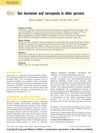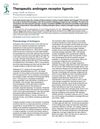Nonsteroidal Tissue Selective Androgen Receptor Modulators: A Promising Class of Clinical Candidates
October 2005
in “
Expert opinion on therapeutic patents
”
TLDR Selective androgen receptor modulators (SARMs) are a promising type of drug for various health conditions due to their targeted actions.
The document discussed nonsteroidal tissue-selective androgen receptor modulators (SARMs) as a promising class of clinical candidates. These SARMs were highlighted for their potential to provide the beneficial effects of androgens, such as muscle growth and bone density improvement, without the undesirable side effects typically associated with steroidal androgens. The research emphasized the importance of tissue selectivity in minimizing adverse effects and maximizing therapeutic benefits, making SARMs a significant focus for future clinical applications.


